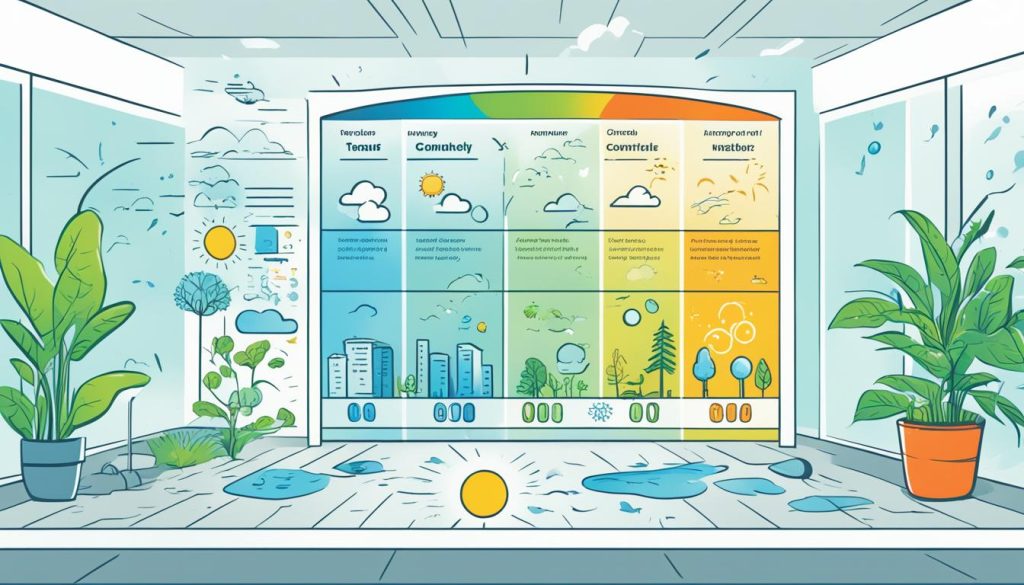Using psychrometric analysis tools can boost your indoor air quality management. These tools help you check and control important factors like temperature, humidity, and pollutants in commercial HVAC systems. Learning HVAC psychrometrics helps you make indoor spaces healthier and more comfortable.
Assessing indoor air quality is key since people spend about 90% of their time indoors. Better air quality can cut down on sick building syndrome symptoms and improve cognitive skills. To do this, increase fresh air intake, control humidity, and manage temperature well.
Psychrometric analysis tools give a scientific way to understand and improve indoor air conditions. With these tools, you can make informed decisions to improve ventilation, cut down on contaminants, and make a better work environment for everyone.
Understanding Indoor Air Quality and Its Importance
Indoor air quality (IAQ) is key to our health and well-being. It affects how we feel, work, and live. Since we’re inside most of the time, knowing what affects IAQ and how to improve it is vital.
The Impact of Indoor Air on Health and Productivity
Poor air quality can cause health problems, from mild discomfort to serious breathing issues. But, clean air can make us think better and work more efficiently. Using smart ventilation and making indoor spaces more comfortable can greatly improve our living areas.
Key Pollutants Affecting Indoor Air Quality
Many pollutants can harm IAQ:
- Particulate matter
- Volatile organic compounds (VOCs)
- Carbon dioxide
- Biological contaminants
Environmental monitoring sensors spot and measure these pollutants. This lets us act fast and keep the air healthy.
Regulatory Standards for Indoor Air Quality
Groups have set rules for good IAQ levels:
| Standard | Focus | Key Requirements |
|---|---|---|
| ASHRAE 62.1 | Ventilation | Minimum ventilation rates |
| OSHA Guidelines | Workplace safety | Acceptable pollutant levels |
| LEED v4 | Green buildings | Higher ventilation rates |
| WELL v2 | Occupant wellness | Lower CO2 levels |
Following these standards and using advanced IAQ management can make indoor spaces healthier and more productive for everyone.
Introduction to Psychrometric Analysis in IAQ Management
Psychrometric analysis is a key tool for improving indoor air quality (IAQ). It looks at the moisture in air, showing you the temperature, humidity, and air movement. This knowledge lets you make indoor spaces healthier and improve HVAC systems.
HVAC psychrometrics are vital for controlling humidity in buildings. They help keep moisture levels right, stopping mold and making spaces more comfortable. With the right analysis, you can keep humidity at the best levels for each indoor area.
Tools for psychrometric analysis make checking indoor air quality more accurate. They measure important air properties. This lets you find problems early and make smart choices. By watching air conditions, you can catch trends and fix issues before they get worse.
| Air Property | Measurement Unit | Importance in IAQ |
|---|---|---|
| Temperature | °F or °C | Affects comfort and microbial growth |
| Relative Humidity | % | Influences moisture-related issues |
| Dew Point | °F or °C | Indicates condensation risk |
| Enthalpy | BTU/lb or kJ/kg | Measures total heat content |
With psychrometric analysis, you can design HVAC systems that are efficient and keep people comfortable. This method helps create healthier indoor spaces and meets air quality standards.
Key Components of Psychrometric Charts
Psychrometric charts are key in HVAC and managing humidity in buildings. They show how different air properties relate to each other. This helps you keep indoor air quality good. Let’s look at the main parts of these charts.
Dry-Bulb Temperature
Dry-bulb temperature is the air’s temperature, measured with a standard thermometer. It’s the chart’s horizontal axis. This is key for comfort and keeping an eye on the environment.
Relative Humidity
Relative humidity shows how much moisture is in the air compared to its max capacity at a certain temperature. It’s a percentage and crucial for controlling humidity. Too much can cause mold, while too little can make people uncomfortable.
Dew Point
The dew point is when water vapor turns into liquid water. It’s vital in HVAC, as it prevents condensation problems. If air cools to its dew point, it gets saturated, which can cause moisture issues.
Enthalpy
Enthalpy is the total heat in the air, including both kinds of heat. It’s key for energy use in HVAC systems. Knowing enthalpy helps make HVAC systems more efficient.
| Component | Unit | Importance in IAQ |
|---|---|---|
| Dry-Bulb Temperature | °F or °C | Thermal comfort |
| Relative Humidity | % | Moisture control |
| Dew Point | °F or °C | Condensation prevention |
| Enthalpy | BTU/lb or kJ/kg | Energy efficiency |
Understanding these components helps you use psychrometric charts to better manage indoor air quality and HVAC systems. Environmental monitoring sensors track these factors, giving you data to keep your building’s conditions just right.
Improve Indoor Air Quality with Psychrometric Analysis
Psychrometric analysis is a key tool for better indoor air quality. It helps understand how temperature, humidity, and other air factors work together. This knowledge lets you make your building’s air quality better.
It also helps make the air more comfortable for people inside. By using psychrometric charts, you can find the perfect air conditions for comfort. This makes the indoor space nicer and more productive.

Getting the right amount of air flow is important for clean air inside. Psychrometric analysis shows the best air exchange rates for different situations. This means you get enough fresh air without wasting energy.
Keeping the right humidity level is key for clean air. This analysis helps manage moisture levels to stop mold and dust mites. Keeping humidity between 30-50% makes the air healthier.
| Psychrometric Analysis Application | Benefit for Indoor Air Quality |
|---|---|
| Temperature and Humidity Optimization | Improved thermal comfort and reduced risk of condensation |
| Ventilation Rate Adjustment | Adequate fresh air supply and removal of pollutants |
| Energy Recovery Analysis | Efficient heat and moisture transfer between supply and exhaust air |
| Dehumidification Strategies | Prevention of mold growth and improved air quality |
Using psychrometric analysis can make your indoor air healthier and more comfortable. It helps you make your HVAC systems work better. This method gives you insights for improving air quality effectively.
Psychrometric Tools for IAQ Assessment
Assessing indoor air quality (IAQ) needs special tools that use HVAC psychrometrics. These tools help measure, analyze, and better air conditions in buildings. Let’s look at the main instruments used in IAQ management.
Digital Psychrometers
Digital psychrometers are key for precise IAQ checks. They use sensors to get temperature and humidity readings. You get instant info on dry-bulb temperature, relative humidity, and dew point. This info is vital for HVAC techs to keep systems running well and ensure comfort.
Software-based Psychrometric Calculators
Advanced software tools work with building automation systems for detailed IAQ analysis. They use HVAC psychrometrics to figure out ventilation rates, contaminant levels, and air change rates. This helps you model different situations and see how HVAC changes affect air quality.
Mobile Apps for On-the-Go Analysis
Smartphone apps make psychrometric analysis easy to do anywhere. You can quickly calculate and check IAQ on-site. Just enter data from sensors and get instant IAQ insights. This lets technicians make quick decisions and adjust HVAC systems for better air quality.
With these psychrometric tools, you can spot IAQ problems, create solutions, and check how well they work. Accurate measurements and strong analysis help make indoor spaces healthier.
Applying Psychrometric Analysis to HVAC Systems
Psychrometric analysis is key to making commercial HVAC systems work better. It helps us understand how air properties interact. This knowledge is crucial for creating efficient climate control solutions. It’s also vital for using less energy and improving automation in buildings.
When using psychrometric analysis with HVAC systems, think about these important points:
- Equipment sizing
- Cooling and heating strategies
- Operating parameters
- Comfort maintenance
- Energy consumption reduction
Engineers use psychrometric charts to find the best settings for HVAC equipment. They look at dry-bulb temperature, relative humidity, and enthalpy. This helps create the perfect indoor climate.
With psychrometric analysis, you can save more energy in commercial HVAC systems:
- Economizer cycles
- Heat recovery systems
- Optimized air distribution
These methods improve the air quality inside and cut down on energy bills. Automation systems use psychrometric data to adjust settings on the fly. This ensures the HVAC system works at its best.
| HVAC Component | Psychrometric Impact | Energy Efficiency Benefit |
|---|---|---|
| Cooling Coils | Dehumidification control | Reduced overcooling |
| Heating Elements | Moisture management | Improved thermal comfort |
| Ventilation Systems | Fresh air optimization | Decreased energy waste |
Learning psychrometric analysis helps design and keep HVAC systems that offer great comfort and use less energy. This method is essential for meeting today’s building efficiency goals. It also helps create healthier indoor spaces.
Case Studies: Successful IAQ Improvements Using Psychrometric Analysis
Real-world examples show how psychrometric analysis tools improve indoor air quality. Let’s look at three scenarios where this method made a big difference.
Office Building Ventilation Optimization
A large corporate office in Chicago had high absenteeism due to poor air quality. They used psychrometric analysis to improve ventilation after an indoor air quality assessment. The results were great:
- 20% reduction in employee sick days
- 15% increase in productivity
- 30% decrease in HVAC energy costs
Hospital Humidity Control Enhancement
A Florida hospital had infection rates due to wrong humidity levels. They used psychrometric analysis for better humidity control. This led to:
- 40% decrease in hospital-acquired infections
- Improved patient recovery times
- Better preservation of medical equipment
School IAQ Management During Pandemic
A New York school district used psychrometric analysis for better air quality during COVID-19. They did this by:
- Adjusting ventilation rates based on occupancy
- Monitoring CO2 levels as an indicator of air quality
- Balancing humidity to reduce virus transmission risk
| Case Study | Challenge | Solution | Outcome |
|---|---|---|---|
| Office Building | High absenteeism | Ventilation optimization | 20% reduction in sick days |
| Hospital | Infection rates | Humidity control | 40% decrease in infections |
| School District | Pandemic safety | IAQ management | Reduced transmission risk |
These case studies show the strength of psychrometric analysis in bettering indoor air quality. By using these tools, places can improve health, comfort, and productivity. They can also use less energy.
Challenges and Limitations of Psychrometric Analysis in IAQ Management
Psychrometric analysis is a key tool for checking indoor air quality. But, it has its challenges. Knowing these limitations is important for managing IAQ well with HVAC psychrometrics.
Getting accurate measurements is key for good results. Sensors must be set up right and calibrated well. Even tiny mistakes in data can lead to wrong conclusions about air quality.

Understanding psychrometric data takes skill. Without the right training, you might get the data wrong. This can lead to ineffective solutions for IAQ. It’s crucial to know how different factors work together on a psychrometric chart.
Changes in how many people are in a building are another challenge. These changes can greatly affect air quality. This makes it hard to keep IAQ levels steady just with psychrometric analysis.
Outdoor air quality also changes and affects indoor air. Your HVAC system might need to adjust based on these changes. But, psychrometric analysis can’t handle this on its own.
| Challenge | Impact on IAQ Management | Possible Solution |
|---|---|---|
| Measurement Accuracy | Incorrect data leads to faulty conclusions | Regular sensor calibration and maintenance |
| Data Interpretation | Misunderstanding psychrometric relationships | Proper training and education for IAQ professionals |
| Occupancy Variations | Inconsistent indoor air conditions | Implement dynamic HVAC control systems |
| Outdoor Air Influence | Unpredictable indoor air quality | Integrate outdoor air monitoring with HVAC controls |
Remember, psychrometric analysis is just part of the puzzle for IAQ. It might not cover all pollutant sources or comfort issues. For full IAQ management, use psychrometric tools with other methods and technologies.
Conclusion
Psychrometric analysis is key to managing indoor air quality today. It lets you create healthier spaces by controlling temperature, humidity, and air flow. These are vital for good indoor air.
This method does more than make spaces comfortable. It’s important for saving energy and keeping people healthy. By using psychrometric data, you can save energy and keep the air clean.
As we move forward, keeping indoor air quality high will be more important. We’ll face tougher health rules and more awareness of air quality issues. Knowing about psychrometric analysis will help you make spaces that are healthy, comfortable, and productive.
Managing indoor air quality is an ongoing task. You need to check, analyze, and adjust often with psychrometric tools. This keeps your spaces at their best. By doing this, you’re looking after the health of people in your building and might even cut costs by using less energy.





0 Comments